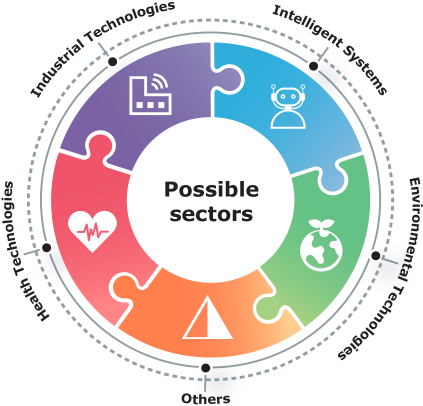About
NUS IP
The NUS IP portal is a one-stop site for interested parties to uncover the breadth of deep
technologies developed in NUS and to discover commercial opportunities.
The technologies encompass a wide range of disciplines from Industrial Technologies, Environmental
Technologies and Intelligent Systems to Health Technologies or a combination of any of these. The IP
encompassing these technologies include patents/patent applications in various geographical
territories, know-how as well as copyright (software).
Examples of commercialized NUS technologies leading to products in the market can be found in
Success Stories. For initial queries on NUS IP, collaboration and licensing, please refer to the FAQ.

Technology Categories
Health Technologies
Health Technologies relate to technologies that encompass the realm of healthcare, including digital health, cell and gene therapies, molecular therapeutics, functional food/nutrition, AI diagnostics, precision medicine, drug discovery, medicinal chemistry, genomics, biomaterials, medical devices, drug delivery and imaging technologies.
Industrial Technologies
Technologies originating from Engineering, or Physical Sciences that present new devices, materials, systems, or processes with higher performance or greater efficiency. New fields of technologies in this category include cutting edge research in spintronics, 2D materials, water and wastewater treatment, optics, electronics and 3D printing.
Intelligent Systems
Intelligent systems relate to software incorporated into Internet-connected secure systems to gather, analyze data and communicate with other systems through Artificial Intelligence. These systems have capacity to perceive and respond to the world around them by learning from experience, and/or adapting to/from current data, developing capability/capacity for remote monitoring and management.
Environment Technologies
Innovations for deployment in urban-built environment/ecosystems, like vertical farming, green buildings, smart cities or industrial parks where newly developed or existing materials or processes, lower overall environmental impact and improves livelihood and lifestyles. This category of technologies can be achieved through the use of green chemistry, biomanufacturing, renewable energy, waste material reuse or with reduced usage of hazardous/unhealthy solvents or reagents.
Others
This category includes all technologies that do not fall into any of the above categories.
All
Technology Readiness Levels (TRL)
Basic research
Scientific research begins with the objective of demonstrating a phenomenon of a concept/principle. Documentation of the research include published papers which identifies the basic principles that underlie the research.
Technology concept and/or application formulated
Once basic principles are observed, practical applications can be formulated. Assumptions of applications are made based on analytic studies and there may not be empirical data to support the assumption.
Proof-of-concept with needs validated
Active R&D is initiated to physically validate the assumptions and analytical predictions of separate, non-integrated elements of the technology. Supporting information includes results of laboratory tests performed to measure parameters of interest and comparison to analytical predictions.
Minimal Viable Product built in laboratory
Basic components are integrated to establish that they will work together. This is relatively “low fidelity” compared with the eventual system. Examples include integration of “ad hoc” hardware in the laboratory with results from testing the low fidelity system.
Product prototype for testing in intended environment
The basic technological components are integrated with other reasonably realistic supporting elements so they can be tested in a simulated environment. Examples include “high-fidelity” laboratory integration of components. Tests conducted on this prototype are more rigorous than that in TRL 4.
Product prototype validated in intended environment
A fully working representative model or prototype system that has been tested in a high-fidelity laboratory environment or in a simulated operational environment. It represents a major step up in a technology’s demonstrated readiness.
Product operates in intended environment with industrial standards
A representative model or prototype system, that has been demonstrated in an operational environment (e.g., in an aircraft, in a vehicle, or in space).
Product is ready for commercial scale-up
A representative model or prototype system has been proven to work in its final form after resolving all issues encountered previously.
Product is available for commercial sale
The technology has been proven to work at its expected scale and under expected conditions in an operational environment.




